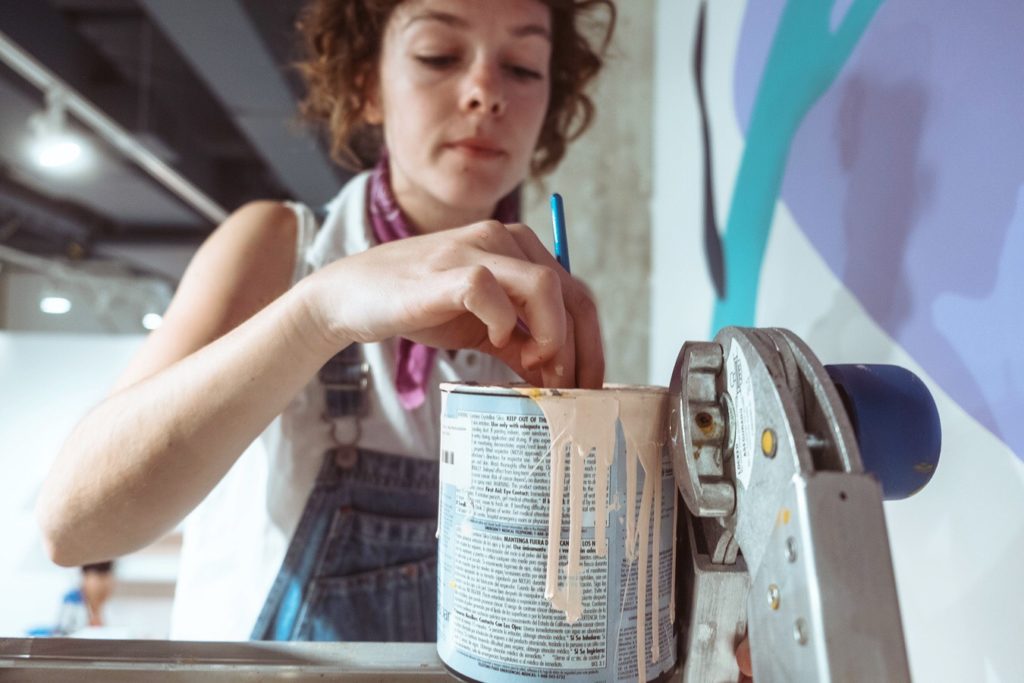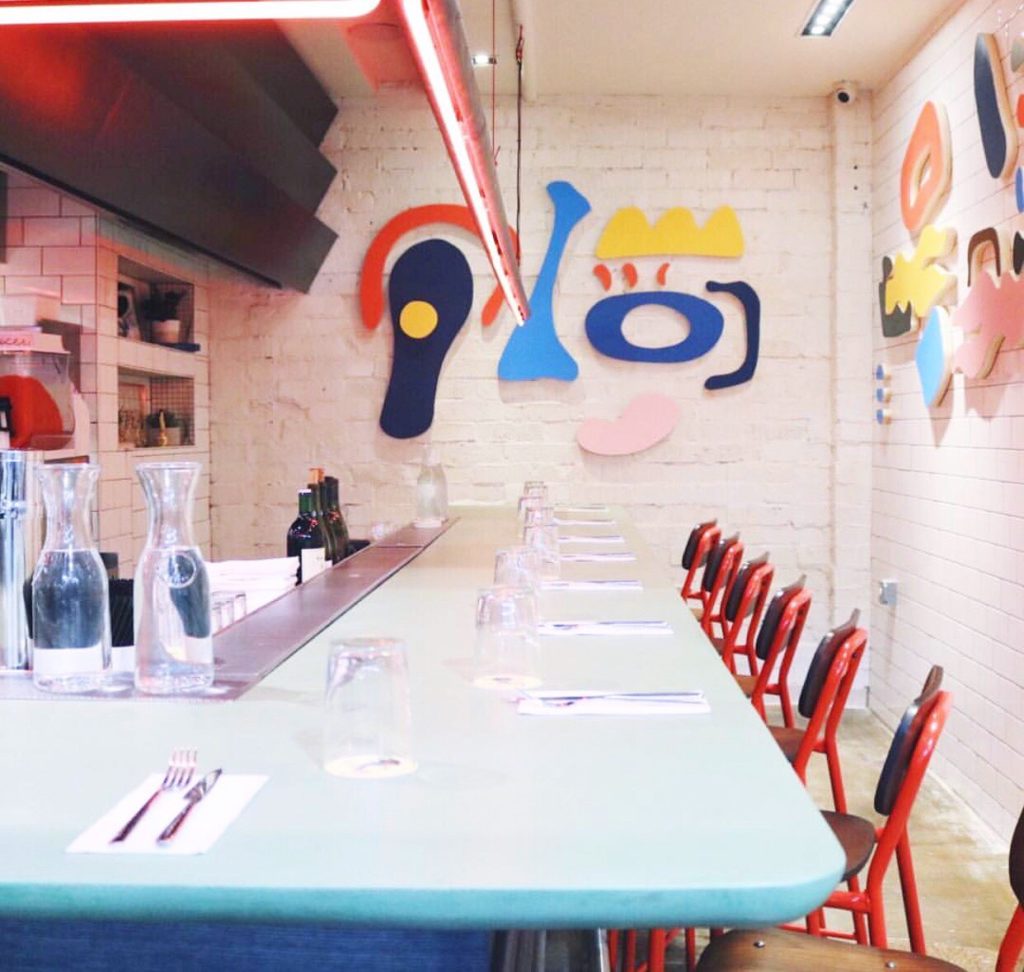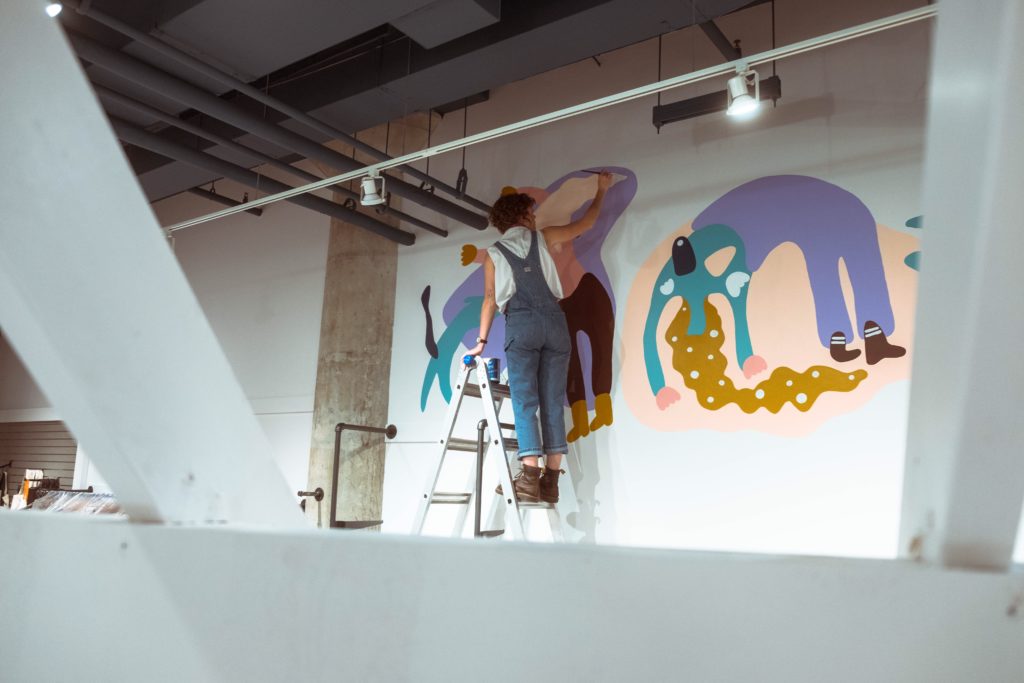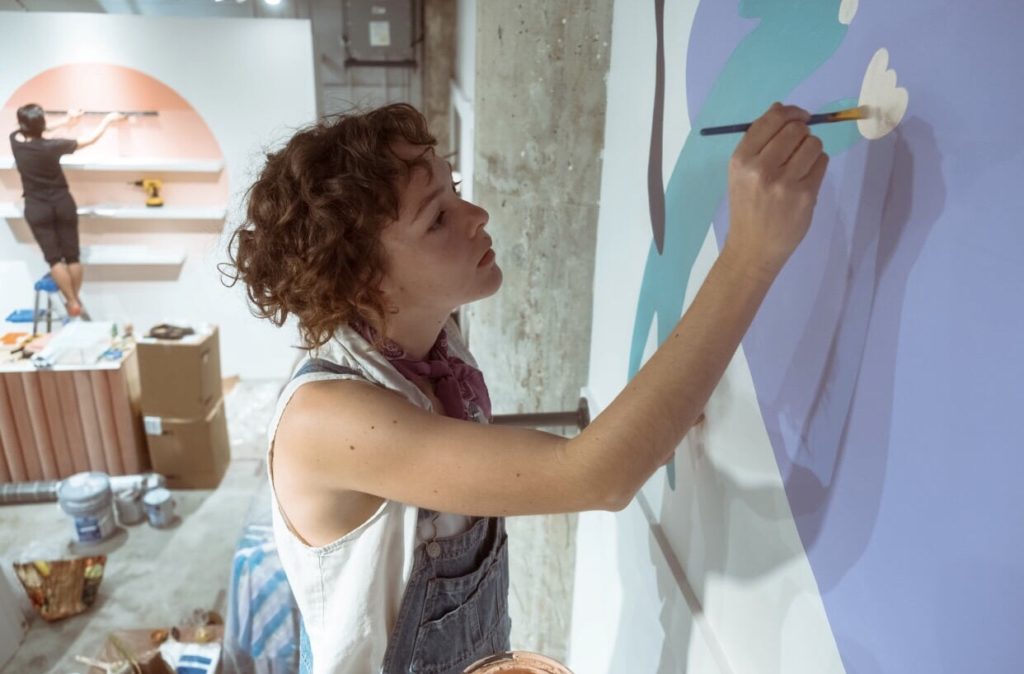There are a handful of local artists whose work is immediately identifiable as their own within seconds of 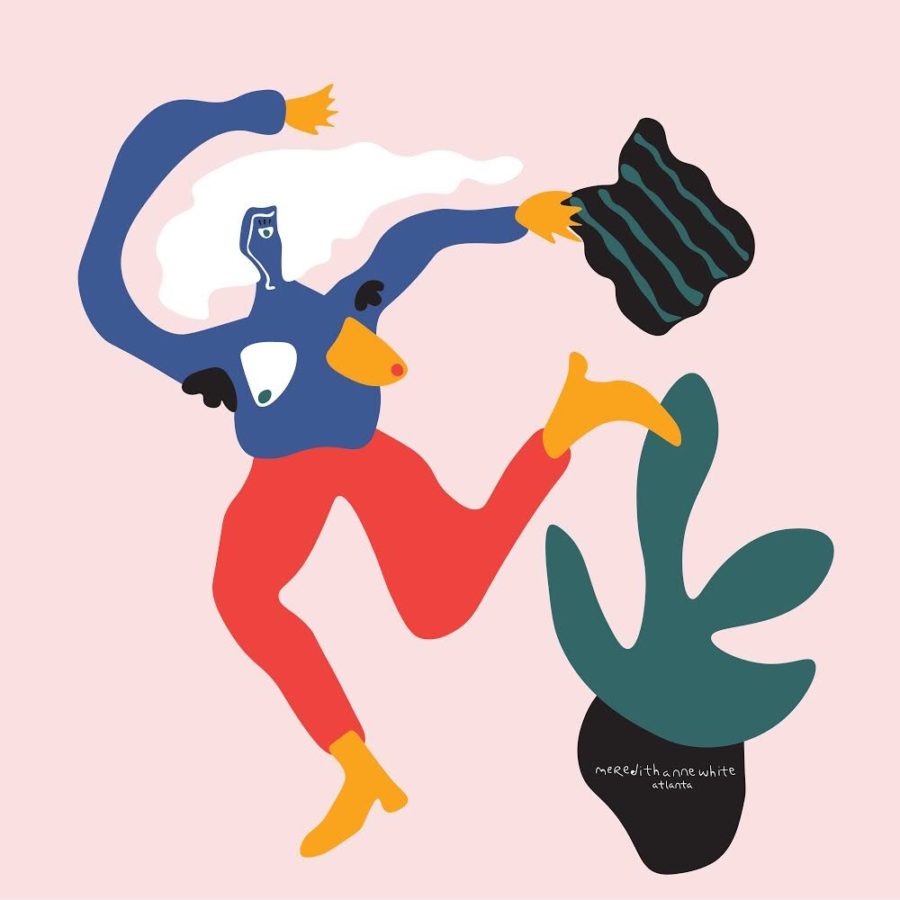 seeing it — Meredith Anne White‘s work falls under that category. Her penchant for organic, cohesive shapes and signature color pairings have garnered her a dedicated fan base, evidenced by her myriad collabs and sizable social following. Her work can be seen on display at restaurants, boutiques and more, both around Atlanta and beyond.
seeing it — Meredith Anne White‘s work falls under that category. Her penchant for organic, cohesive shapes and signature color pairings have garnered her a dedicated fan base, evidenced by her myriad collabs and sizable social following. Her work can be seen on display at restaurants, boutiques and more, both around Atlanta and beyond.
A native of Alpharetta, White began school at Georgia College in Milledgeville before transferring to The University of Georgia for their art program. While she majored in Art History and minored in Studio, the artist directed her focus towards modern and postmodern studies with a lens on gender. A current Reynoldstown dweller, she feels a deep connection to her neighborhood and encourages everyone to support their own communities in whatever ways they can.
White talked to CommonCreativ about using her voice as a means for positive change, the lack of diversity she sees in Atlanta’s arts scene, and the importance of showing up.
CommonCreativ: How did you end up in Atlanta?
Meredith White: I graduated college in 2015 and moved down here to work at the Museum of Design Atlanta on Exhibitions for Designers, Makers, Users: 3D Printing the Future. So about three years I’ve been down here!
CC: What first sparked your interest in art?
MW: One of my first memories is one of creation. I was asked to do a self-portrait when I was about 7, and came up with a drawing that was unlike any of my classmates. I wondered why mine didn’t necessarily look like me but conveyed more of my personality. It was then that I understood that art could be a means of expression versus representation.
CC: How would you describe the aesthetic of your work in one sentence?
MW: I’d describe my work as bright yet confrontational.
CC: What inspires your pieces, particularly your color palettes?
MW: I’m incredibly awed and inspired by the interactions that take place between different communities and how those communities respond to the shifts in life by means of creation. We can learn so much about a culture and society: Did they build structures? Did they create a language? Did they practice religion? In turn, we can explore what was most important to them because of the documentation of those things.
My palette varies! I’m pushing myself to work with bolder and brighter colors in conjunction with large, organic shapes. Each component works together to capture your attention and raise questions.
CC: You’ve said your work has “evolved into a lifestyle, gaining strength from the resilience of women, the voice of the modern, and the interpretation of postmodern culture as it affects human and civil rights.” Talk a little more about that.
MW: I promised myself in 2016 that I would use my voice as a means for positive change. I left my job on a quest to settle some of the unrest that was taking place internally for me. By doing so, I began to practice the act of creation every day. I’m able to produce work that is relatable, work that speaks to our political system, work that stands up for the underdog, work that touches on the rights that are inherently female. It’s important to raise questions!
CC: How did you become involved in creating pieces for the local restaurant industry?
MW: While I was working part-time at MODA right out of school, I took a part-time job at Leon’s [Full Service] in Decatur. It was the only way I could afford a place in Atlanta at the time. I learned that many of the same people I worked with used the service industry as a means to fuel their creative passions as well. Not only did some of those people become lifelong friends, but those people also continued to reach out to me for creative opportunities. I consider myself very lucky to have met those people when I did; I wouldn’t be here without them.
CC: What does the creative process look like for you?
MW: My process changes from time to time. I like to bring my sketchbook to museums and spend hours sitting on the floor mimicking brush strokes, colors, figures, etc. I bring those sketches home and play with them. I’ll rearrange shapes, overlay washes, add hatching, and thus bring into the computer. It’s really exciting to play around with color palettes and spatial arrangement before committing to a physical surface. I’ve fallen in love with illustrating on my computer first and later translating that into a large-scale piece.
CC: What have been some of your greatest achievements as an artist and maker?
MW: I’d like to think that those achievements directly relate to those that are positively affected by my work. When an individual tells me he or she felt included, inspired, and even a little more willing to open up to their own means of creation, I’m flattered.
CC: Who are some of your favorite artists?
MW: I studied Art History in school, so this list could go on for a really long time. I originally became interested in post-war artists like Helen Frankenthaler, Jackson Pollock, and Peggy Guggenheim. I took film photography courses all throughout school, so artists such as Cindy Sherman, Nan Goldin, and Alfred Hitchcock should be recognized. A few artists positioned themselves at the forefront of my mind within recent exhibitions that I’ve seen. Henri Matisse, Marcel Duchamp, Louise Bourgeois, and Gino Severini take the cake.
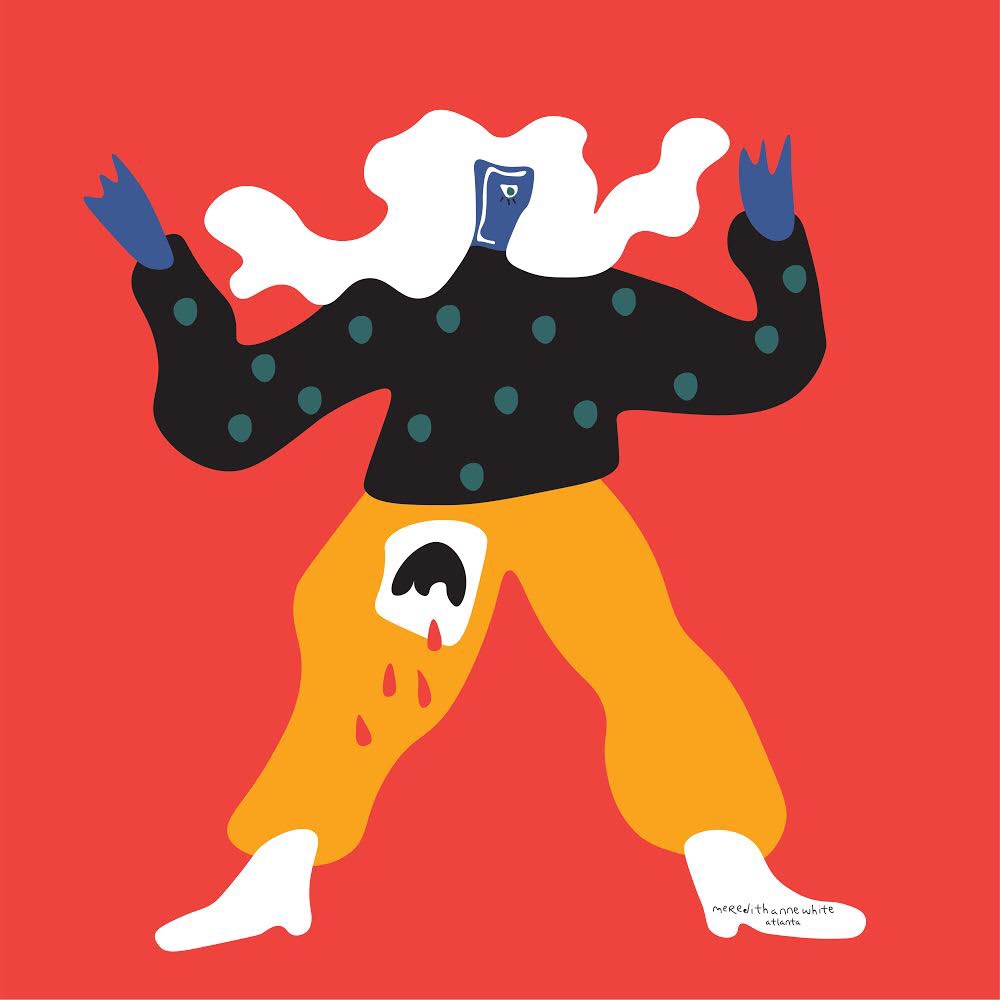 CC: How do you effectively promote yourself and your work?
CC: How do you effectively promote yourself and your work?
MW: I do a good bit of networking via social media like Instagram, but I network the most by just talking to people. Being present in the creative community is extremely important to me.
CC: What advice do you have for artists looking to develop their own style?
MW: I would always encourage anyone to show up for the things that matter to them. My work is closely tied to the neighborhood that I live in and support. I volunteer for organizations, such as Living Walls, that are continuing to change the face of Atlanta in terms of inclusivity, diversity, and the arts. In doing so, people have supported me on my journey as a freelance artist. If you show up for the people and causes that you support, they will begin to do the same for you.
CC: What do you think about the current state of Atlanta’s art scene?
MW: I think Atlanta’s art scene has a great deal of potential but is completely lacking in diversity. It’s catering to one kind of creation, therefore limiting the way in which individuals are able to show work in Atlanta. Let’s change that! Show work of females without naming them as “female shows.” Show work from people of color. Show work of individuals that are different from yourself. It’s important to see and hear voices from all communities.
CC: What’s next for you?
MW: I recently completed an insanely fun project with my Castellucci [Hospitality Group] fam over at Krog Street Market. It’s a new restaurant called Recess. I was able to create 2-inch thick woodcuts that were then arranged in various ways along three separate walls. It was like constructing a giant puzzle! And I just finished a mural that stretches across an 18-foot wall in Coco + Mischa at Ponce City Market! The mural takes on 3 different personas of women. It’s representative of the ladies who work there (that I love) and those that shop and support us. They’re hosting a grand opening April 15th — check it out
CC: Lastly, why do you create?
MW: I create as a means to blow off steam. I create to express myself. I create to show those that being different is okay. It’s okay to be weird. It’s okay to be frustrated. It’s okay to be queer. Be yourself and use your voice. I create for many reasons. I find that those reasons continue to change as I do.
See more of Meredith’s work on her portfolio site and Instagram.

